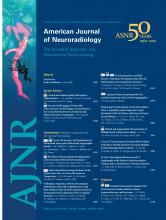Abstract
BACKGROUND AND PURPOSE: Previous articles have demonstrated that carotid artery plaques may have enhancement after administration of contrast material. The purpose of this study was to evaluate the effect of enhancement in carotid artery classification.
MATERIALS AND METHODS: Three hundred eighty consecutive patients (235 men, 145 women; median age 64, age range 32–87 years) were analyzed using a multidetector row CT scanner. Examinations were performed before and after CM administration. Carotid artery plaques with a attenuation value <60 HU were considered fatty, those from 60–130 HU were considered mixed, and those >130 HU were considered calcified. χ2 tests, Student t tests, and Cohen analyses were performed.
RESULTS: Before CM administration, we observed 226 calcified, 175 mixed, and 206 fatty plaques; after CM administration, 229 calcified, 213 mixed, and 165 fatty plaques were observed. A statistically significant difference between these 2 groups was observed (P = .016). We found that 19.9% of fatty plaques become mixed (n = 41), whereas 1.7% of the mixed plaques become calcified (n = 3). All calcified plaques remained in the same category. Fatty plaques that changed type showed a larger enhancement compared with those that remained in the same class (P = .001). Cohen analyses showed very good agreement between observers before (κ = 0.834) and after contrast material administration (κ = 0.86).
CONCLUSIONS: The results of this study indicate that the carotid artery plaques (fatty and mixed) significantly change according to whether analysis is performed before or after administration of contrast material.
ABBREVIATIONS:
- CM
- contrast medium
- CPE
- contrast plaque enhancement
- HU
- Hounsfield unit
- MDCTA
- multidetector row CT angiography
- US
- ultrasound
- © 2012 by American Journal of Neuroradiology












